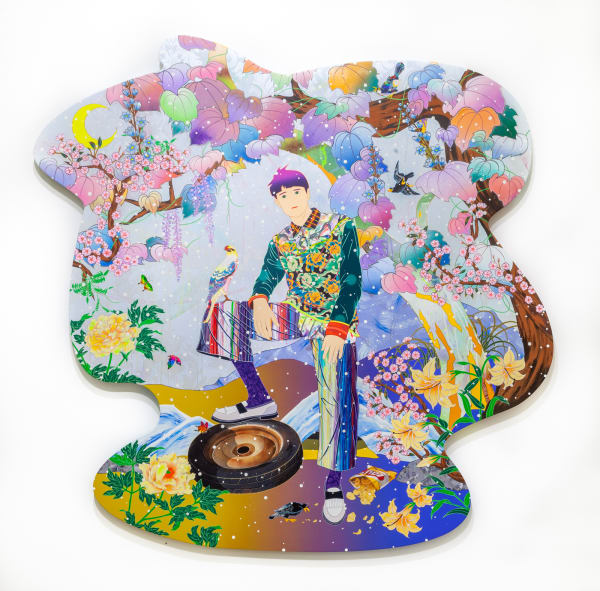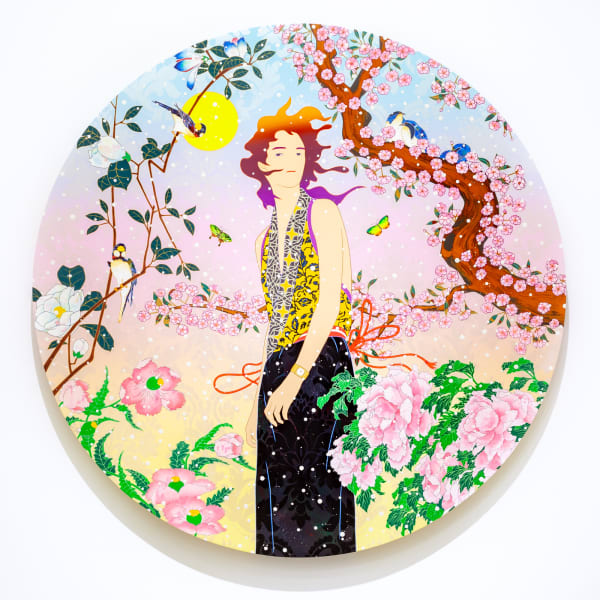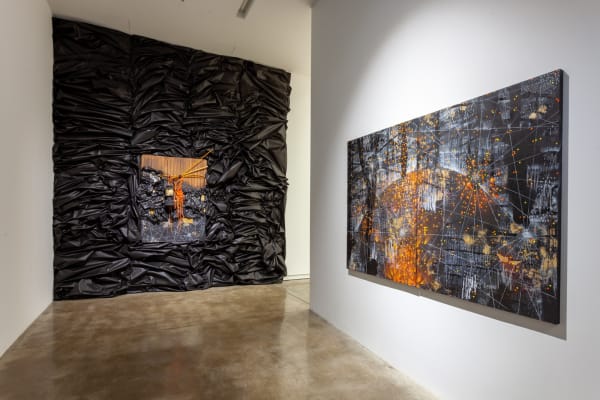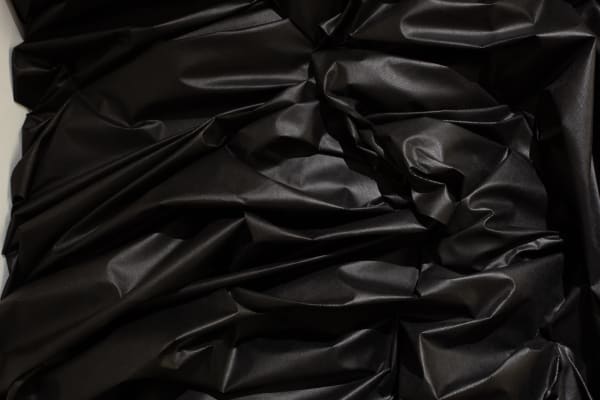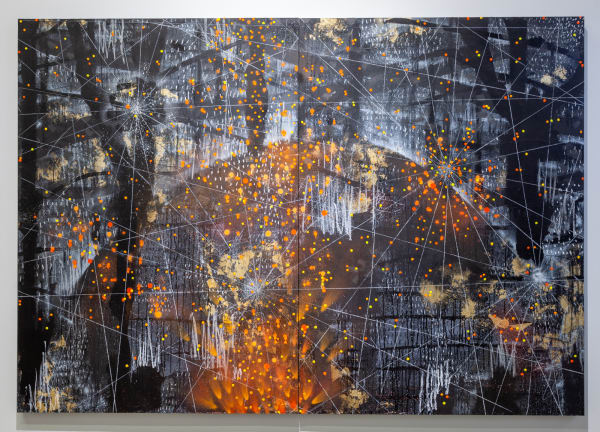-

-
Kavi Gupta is proud to present Realms of Refuge, a group show bringing together for the first time new works by eight of the most dynamic artists working today: Dominic Chambers, Allana Clarke, Basil Kincaid, Tomokazu Matsuyama, Suchitra Mattai, Michi Meko, Devan Shimoyama, and Alisa Sikelianos-Carter.
Focusing inward—in visual, material, narrative, and symbolic ways—the works collectively speak to the desire to retreat from the oppressive gaze, towards a safe space for creativity and renewal.
“Rest and stillness are essential to the creative act,” says curator Chanelle Lacy, Associate Director and Programming Manager for Kavi Gupta. “Realms of Refuge are both literal and symbolic metaphysical zones—anywhere the intellect is nurtured, instinct is unhindered, and the soul is free to wander. These are the spaces in which we process our thoughts and alchemize not only our lived experiences, but also those of our ancestors; it is in these realms that we're free to transcend our earthly entanglements, reaching higher states of consciousness, embodiment, and expression."
-
-
-
Dominic Chambers’s idyllic painting Window Sitter, depicting a single Black figure peering out into a warm and luminescent cloudscape, continues the artist’s examination of leisure, magical realism, and the Black subject.
“Often for Black people, specifically those on the lower economic ladder, the act of peering out of the window is a precarious experience,” says Chambers, “a reminder of the disparaging conditions in which one lives. My aim is to provide a scene of a Black subject peering out of the window and into a space where one’s circumstances (political or environmental) cease to be a concern. The view beyond the window is one that provides an opportunity for introspection and reimagining what is possible. To quote Donna Summer: ‘Write your name across the sky.’
-
A new large-scale painting by Devan Shimoyama shows a glittery, full-body portrait of Shimoyama’s friend Anthony, seated in meditation. The seven chakras glow on his body, as silhouettes of his body fan out from the root chakra at the center point. The work is the second in a series of paintings Shimoyama has made that are informed by the artist’s explorations of healing practices, magic, mysticism, mythologies, and religions.
Says Shimoyama, “I’ve noticed through my own exploration of these topics that there seem to be so many connections, a through line between them. For example, I have a strong connection to The Star tarot card, and discovered that the traditional illustration shows seven stars in the sky that represent the seven chakras. The Star tarot card has so much to do with hope, good health, and spirituality, and that seems so directly connected to meditation and the chakras, which some friends of mine have been looking to recently as a way of healing."
-
New sculptural works by Allana Clarke express ritualistic transformation through performative gestures embedded in surfaces constructed from hair bonding glue, a liquid latex commonly used to adhere hair extensions onto a person’s scalp. Clarke manipulates the material by scraping it, pulling it, twisting it, and pushing into it with her entire body. This performative process of molding the material through her physical actions manifests as a sculptural relic of the artist literally grappling with her complicated relationship with a medium connected to her experiences as a child of “rituals indoctrinating me into a world that is anti-Black.”
“I was in the studio every single day, using that time as an escape from the world and the immense amount of trauma I was absorbing,” Clarke says. “I needed to feel human again. I needed to orient myself towards futurity; towards a future where Black bodies can be articulated in a way they’ve never been before. My practice is the process of that.”
-
Two new paintings by Alisa Sikelianos-Carter present as mythological bridges between the spirit world, infinite spacetime, magic, and myth. Layering fabrics and paint into controlled, maximal compositions, Sikelianos-Carter illustrates the mythological future stories of the Black diaspora: stories in which her characters—such as the Future Ancestors and the Afronauts—inhabit the fantasy folds of time like gods, traveling between our world and the infinite possible worlds to come.
“I’m stretching out time in a way that doesn’t just go forward,” Sikelianos-Carter says. “If you had a telescope long enough, from far enough away you could look through it and see Egyptians building pyramids right now. All time is happening at every moment.”
-
Two new paintings by Tomokazu Matsuyama elegantly express what the artist refers to as “the struggle of reckoning the familiar local with the familiar global.” A first-generation Japanese American who lives and works in New York City, Matsuyama is keenly aware of the nomadic diaspora, a community of wandering people who seek to understand their place in a world full of contrasting visual and cultural dialects. The two pieces Matsuyama created for Realms of Refuge feature amalgams of references, including figures borrowed from fashion magazines; clothing reminiscent of historic Japanese garments; backgrounds evocative of Shogun-era screens and panels; curved canvases that simultaneously recollect mid-century Modernist Minimalism and the far more ancient history of shaped tea platters; and elements such as a junkyard tire and a bag of potato chips that situate the images starkly in the present age.
“The convenience of our time has made how layered our culture is indefinite,” says Matsuyama. “I’m trying to define the boundaries of something that’s in between. When we see an image, we try to find connections. I accumulate all of this visual dialect and bring it together as though it has meaning, and the viewers make up a story based on their upbringing.”
-
Michi Meko has always been interested in the languages of wilderness spaces—those within himself and the natural world alike. In preparation to make his works for Realms of Refuge, Meko ventured out on hikes and camping and fishing trips, taking field notes and exploring whether he could personify nature as much as the typically white male voices that dominate the genre of nature writing, such as Whitman, Theoreau, and Muir. “I was curious enough to ask myself what it means when we turn ourselves from gazing outward at a mountaintop or a valley, inward towards whatever mountaintop or valley is in ourselves,” says Meko. “I wondered, is the transcendent moment the scenery, or the view? Or is it the inward reflection that appears to be an outward gaze?”
-
-
 Michi MekoInna Silk Suit Trying Not To Sweat., 2021Acrylic, Gold Leaf, Oil Pastel, White Prismacolor Pencil (pc938), Areosol,
Michi MekoInna Silk Suit Trying Not To Sweat., 2021Acrylic, Gold Leaf, Oil Pastel, White Prismacolor Pencil (pc938), Areosol,
Areosol Holigram Glitter, Gouache, India Ink, Krink on Panel56 x 80 in
142.2 x 203.2 cm -
 Michi MekoThe Long View, 2021Acrylic, Gold Leaf, Oil Pastel, White Prismacolor Pencil (pc938), Areosol, Areosol Holigram Glitter, Gouache, India Ink, Krink on Canvas60 x 84 x 1.25 in
Michi MekoThe Long View, 2021Acrylic, Gold Leaf, Oil Pastel, White Prismacolor Pencil (pc938), Areosol, Areosol Holigram Glitter, Gouache, India Ink, Krink on Canvas60 x 84 x 1.25 in
152.4 x 213.4 x 3.2 cm
-
-
Suchitra Mattai blends painting, sculpture, and installation with domestic labor techniques she learned from her grandmother, such as sewing, embroidery, and crocheting. Her sculptural paintings tell visual stories that touch on her Indo-Caribbean lineage, addressing such topics as the legacy of colonialism, and relationships between culture and gender roles. The three works she contributes to Realms of Refuge are rife with found materials—such as a colonial Belgium tapestry, her mother’s wedding saris, embroidery hoops, and vintage brooches—that have their own embedded meanings, creating a call and response between the materials, the topics addressed in the work, and processes involved in the work’s creation. The works carve new spaces for radical imagination, transmogrifying official accounts of the heritage of Indo-Caribbean people. The uncanny feeling being evoked is that of an idyllic yet unfinished world.
-
“I say I’m a storyteller, but the story does not only come from history,” says Mattai. “When you’re thinking about what constitutes memory, it’s part truth and it’s part myth.”
-
-
Basil Kincaid introduces two key works from his new body of figurative quilts in Realms of Refuge. The quilts are inspired by narratives that relate to the intersection of his personal history with the broader history of his various communities, including the larger African American community, the church in which he was brought up, and the community he has become part of on his trips over the years to live and work in Ghana. Examining where convention can become pliable enough to start creating new conventions, Kincaid’s new quilts activate concepts such as the role of dreams in the creative act, and the concept of rest as a revolutionary activity.
Basil Kincaid introduces two key works from his new body of figurative quilts in Realms of Refuge. The quilts are inspired by narratives that relate to the intersection of his personal history with the broader history of his various communities, including the larger African American community, the church in which he was brought up, and the community he has become part of on his trips over the years to live and work in Ghana.Examining where convention can become pliable enough to start creating new conventions, Kincaid’s new quilts activate concepts such as the role of dreams in the creative act, and the concept of rest as a revolutionary activity.
-
Like all of the artists in Realms of Refuge, Kincaid is consciously creating works that speak to the need to make a safe space for reflection and creativity, where it is possible for someone to visualize living their best life. Summarizing what the entire exhibition is really about, Kincaid paraphrases a James Baldwin quote: “A place where you will belong won’t exist until you create it.”
Realms of Refuge is on view July 10 through October 30 at Kavi Gupta, 219 N. Elizabeth St. Chicago, IL 60607.








